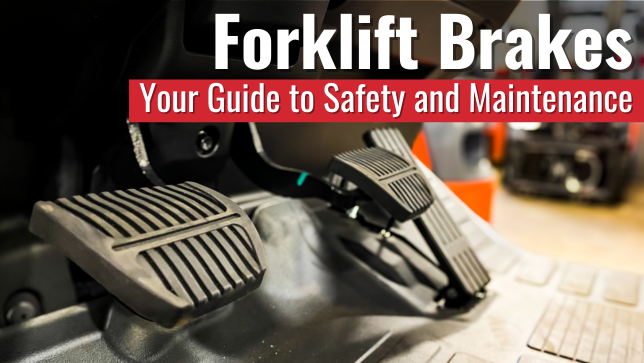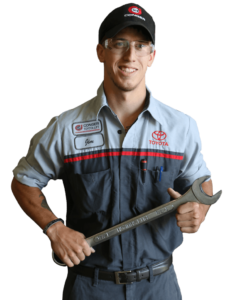Are you Looking to enhance the performance and safety of your forklift brakes? Well, you have come to the right spot!
In this article, we will dive into the world of forklift brakes, from their fundamental mechanics to sophisticated maintenance strategies, equipping you with vital insights and knowledge.
We will cover essential topics like:
- Understanding core concepts
- Choosing the right brakes
- Maintenance and troubleshooting common problems
- Enhancing operational safety
- Exploring advancements in braking technology
- Adhering to legal standards
- And much more!
Your comprehensive guide awaits.
Let’s dive in!
Understanding Forklift Brakes Fundamentals

Forklift brakes might not be a glamorous part of your material handling equipment, but they are undoubtedly among the most critical. Think of them as the unsung heroes that keep operations safe and efficient.
The Braking System
The braking system in a forklift is more than just a pedal on the floor. It is a complex coordination of multiple brake parts working in unison to bring your forklift to a halt.
The master cylinder acts as a conductor, adjusting the brake fluid pressure directed to the calipers or brake drums. This action forces brake pads or shoes against rotating components, creating friction that slows down your vehicle.
Beyond these basics are auxiliary parts like return springs (which provide a light pull on the forklift brake shoes when you lift off the pedal) and boosters that amplify the force of your foot, making stopping less of a workout.
Components of Forklift Brakes

Brake Pedal
The brake pedal is your initial contact when decelerating or coming to a halt, linking you directly to the braking system. This connection enables you to modulate pressure for a seamless stop.
In the tight spaces where forklifts operate, a responsive brake pedal is crucial to avoiding accidents. Think of it as your best friend in high-stakes situations where precision matters most.
Master Cylinder
This component converts the force from your foot on the brake pedal into hydraulic pressure. Without it, transferring that stopping power to the brakes would be like trying to play tennis with a baseball bat—ineffective and awkward.
It is crucial to maintain the master cylinder in excellent condition, as its failure can directly lead to brake malfunction. Regular checks are not a recommendation; they are essential for safe operation.
Wheel Cylinder
A wheel cylinder is a key part of a drum brake system, typically found in many types of forklifts. It converts hydraulic pressure from the master cylinder into mechanical force which then applies the brakes. When an operator presses down on the brake pedal, fluid is sent through lines to each wheel’s cylinder, pushing pistons outward and forcing brake shoes against the drum to create friction—thereby slowing or stopping motion.

Brake Lines and Hoses
The unsung heroes of your braking system, these tubes transport pressurized hydraulic fluid from the master cylinder to the brakes at each wheel. Picture them as vital arteries for keeping the heart of your forklift pumping.
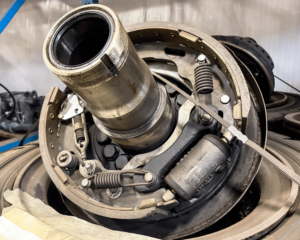
Drum Brakes or Disc Brakes
Forklifts come equipped with either drum or disc brakes at each wheel site. Drum brakes use brake shoes pressing outward against a spinning surface called a drum; think about rubbing two sticks together to make fire—friction creates friction, slowing the rotation down. Disc brakes work similarly but squeeze inward on both sides of a disc (or rotor), offering better heat dissipation during long work sessions that demand a long performance without overheating risks.
Parking Brake
Having a parking brake engaged ensures the forklift’s stability, a vital safety measure during loading and unloading operations in warehouses or docks. It prevents accidental movement, safeguarding valuable cargo from potential damage.
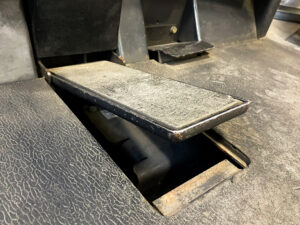
Deadman switch
A deadman switch on a forklift is a fail-safe mechanism on select forklifts that automatically halts the vehicle’s movement if the operator loses control or becomes incapacitated while at the controls. Typically located on the floorboard or as part of the seat sensor system, this switch requires constant pressure from the operator to keep the forklift operational. When said pressure is released—whether due to an operator stepping away or unable to maintain contact—the forklift stops.
Key Takeaway:
Forklift brake components are crucial for safety and require regular brake maintenance to maintain peak performance and avoid accidents.
Maintenance Tips for Forklift Brakes

Maintaining your forklift brakes is not just crucial for safety; it also ensures the equipment operates smoothly and with optimal efficiency. Here are some tips to help you avoid expensive repairs and ensure that your forklift brakes do not let you down when you need them most.
Clean your Brake System
In a dusty, debris-filled environment, forklifts move forward, risking clogged brakes and reduced stopping ability amidst the clutter. Regularly cleaning these parts can prevent brake dust buildup that might lead to significant issues in the future.
A simple yet effective way to keep things clean is by using compressed air to blow away any debris from around the braking system components. However, be cautious not to damage sensitive parts with high-pressure air blasts.
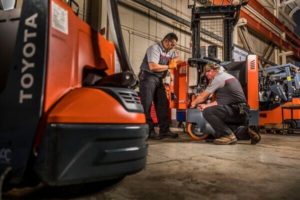
Routine Checks
Routine checks and maintenance are critical if you want your forklift to perform in top shape, and let’s face it. No one wants their forklift to go rogue due to failed brakes during peak hours. Routine checks involve inspecting brake pads, fluids, drums or rotors, and other components as part of routine servicing schedules. Effective planned maintenance ensures that any potential problems are addressed before they escalate into major issues that could halt operations and endanger workers.
- Daily Forklift Checks: Operators should perform daily brake inspections looking out for signs like unusual noises or decreased stopping power which might indicate worn-out brake components.
- Scheduled Servicing: Adhering to manufacturer-recommended forklift service intervals helps maintain optimal brake function and prevents unexpected failures.
- OEM Parts: Use original equipment manufacturer (OEM) parts during replacements to guarantee compatibility and reliability.
Forklift Brake Performance Review: Compare Different Types
The type of braking system used in a forklift can affect its performance under various conditions. For instance,
- Mechanical Brakes: Often found in older models requiring manual adjustments. However, their simple design makes them easy to fix with a few basic tools.
- Hydraulic Brakes: A common feature in modern electric and internal combustion lift trucks providing smoother operation but may require more frequent fluid checks.
- Air Brakes: Ideal for heavy-duty applications seen mostly on larger vehicles that offer superior stopping power that is necessary when transporting substantial loads.
The Importance of Professional Servicing
No matter how diligent you are with routine checks, professional servicing takes things to another level by addressing issues beyond surface-level inspections. Professionals have the specialized tools and expertise to identify complex problems, replace defective components accurately, and adjust systems for optimal performance. A professional maintenance plan ensures everything operates smoothly and reduces downtime caused by unexpected breakdowns.
This servicing not only prolongs the lifespan of your equipment but also keeps forklift operators safe—a win-win situation.
Troubleshooting Common Brake Problems

When your forklift brakes begin to malfunction, it is like halting a rampaging bull with just a red scarf. Far from perfect. Here are typical brake damage problems and strategies for addressing them.
Squeaking or Grinding Noises
If your forklift sounds more like a door in a horror movie than heavy machinery, there is definitely a problem. Squeaking usually points towards worn-out brake pads or brake shoes. On the other hand, grinding could mean those components have worn down completely, allowing metal-on-metal contact.
To fix this spooky scenario, regularly inspect the brake pads and shoes as part of your maintenance routine. If they are thinning out like ice cream on a hot day, replace them pronto.
Poor Braking Performance
When stepping on the brakes feels more like hoping than halting, it is clear that your brakes are performing poorly. This issue could be due to air in the hydraulic system or low fluid levels.
Bleeding the brakes removes pesky air pockets that diminish hydraulic pressure while checking and topping off brake fluid can ensure smooth operation. Maintaining your hydraulic system is critical here.
Forklift Pulling to One Side When Braking
Navigating becomes challenging when your forklift unexpectedly veers off course during braking. It often stems from uneven wear on brake components or issues within the steering mechanism.
To address this pulling problem, ensure regular wheel alignment checks and uniform wear on all brake components.
Vibration When Braking
Are you experiencing vibration when braking can be both a discomfort and a red flag for operators of material-handling equipment, particularly forklifts? Vibration or shuddering through the steering wheel or pedal during braking often points to issues within the brake system.
Common culprits include warped brake rotors, worn-out brake pads, or even accumulated debris that interferes with smooth operation. These conditions can significantly impact your stopping power and and your brakes require immediate attention.
Key Takeaway:
Do not let brake issues turn your forklift into a runaway train. Regular checks and maintenance plans for pads, fluid levels, and wheel alignment can stop problems in their tracks.
Innovations in Forklift Brake Technology
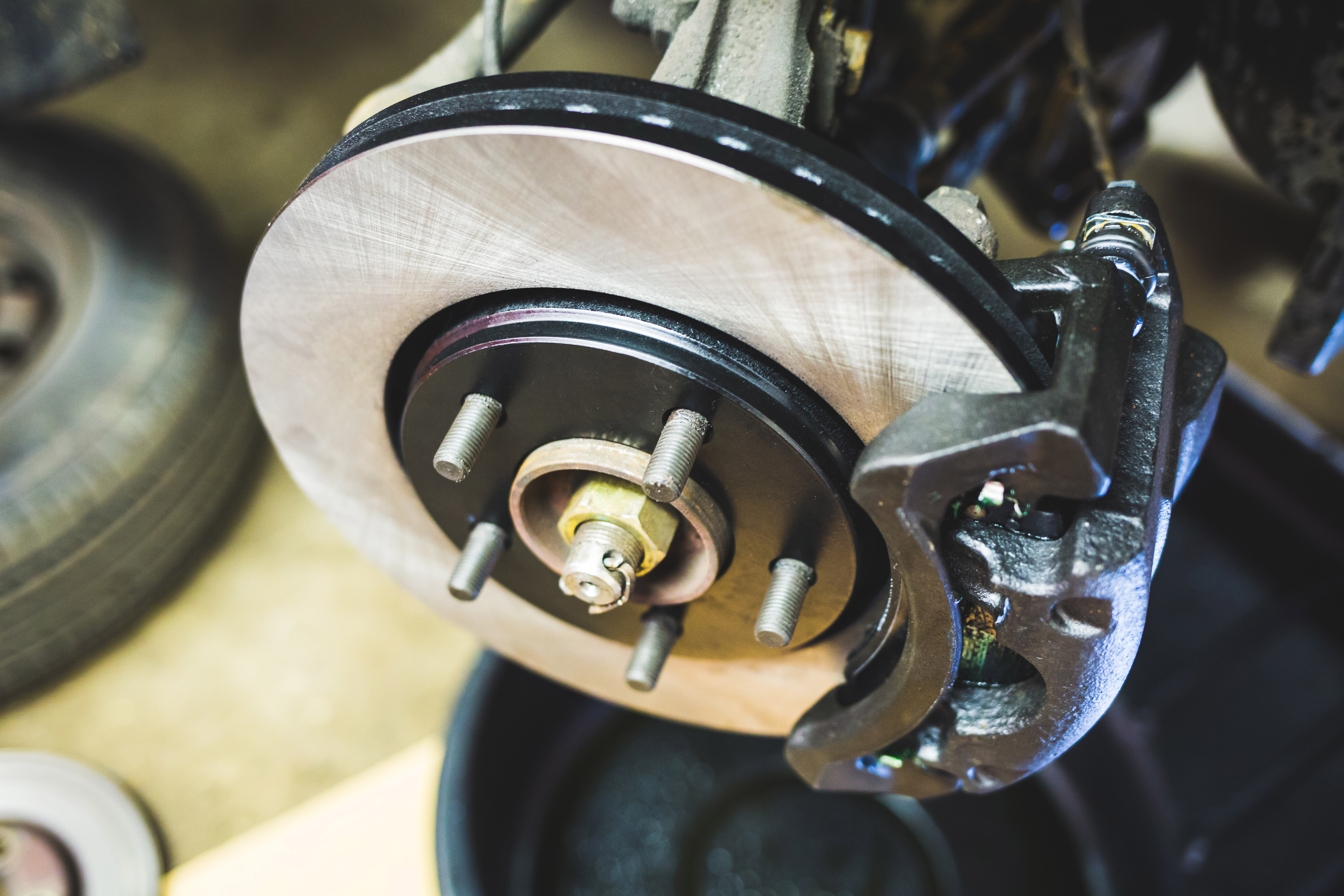
Recently, the development of braking systems in forklifts has significantly advanced, transforming from basic safety features into essential components for forklift operation.
Regenerative Braking Systems
Forklift manufacturers have turned towards regenerative braking systems, a technology borrowed from the electric vehicle industry. When operators apply the brakes on a forklift, this system captures the energy and redirects it to recharge its own battery. Not only does this extend the battery life, but it also reduces wear on traditional brake components, leading to lower maintenance costs.
An added bonus of regenerative braking is its contribution to sustainability efforts within operations by reducing energy consumption overall. Learn more about how these systems work by exploring regenerative braking technologies explained by the U.S. Department of Energy.
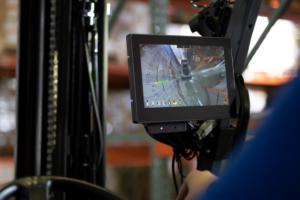
Automatic Emergency Braking (AEB)
Incorporating Automatic Emergency Braking (AEB) into forklifts marks a significant advancement in our ongoing journey toward enhancing workplace safety. AEB systems use sensors and cameras to detect potential collisions before automatically applying the brakes.
This approach proactively addresses potential mistakes or distractions, which improves warehouse safety. It dramatically reduces accidents, safeguarding products and decreasing the chance of worker injuries.
Air Disc Brakes Over Traditional Drum Brakes
Transitioning from drum to air disc brakes offers numerous benefits, including improved cooling, reduced stopping distances, and lower maintenance needs due to their design.
Key Takeaway:
Forklift brakes have come a long way, boosting safety and performance. From regenerative systems that save energy and cut maintenance costs to Automatic Emergency Braking (AEB) preventing accidents, these advances make the workplace safer. Plus, switching to air disc brakes means better control with less upkeep.
Choosing the Right Forklift Brakes for Your Needs

Forklift brakes are like your trusty sidekick, always there to save the day when things get too fast or out of control. But not all heroes wear capes; some come in the form of robust braking systems designed to meet various operational demands.
Understanding Your Environment
The environment where your forklift operates plays a role in determining the type of brakes. Indoor warehouses with smooth flooring might get away with standard braking systems, while rough outdoor terrains demand more rugged solutions. Understanding the nuances of your operating environment, like fluctuating temperatures and different ground textures, is vital in choosing an appropriate braking mechanism.
An excellent place to start is by checking guidelines provided by manufacturers on their websites or reaching out directly for advice tailored to your specific needs.
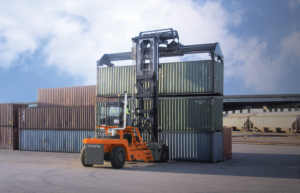
Evaluating Load Capacity and Frequency of Use
Your workload also impacts brake selection. Heavy loads need brakes that can handle high stress without wearing down quickly. On the other hand, light loads might not require as much from their braking systems but still benefit from efficient and responsive options.
When selecting brakes for your forklifts, consider the weight of materials they regularly carry and their usage frequency. For heavy-duty operations, choose durable and reliable brakes that consistently perform well to ensure safety without compromise.
Drum Brakes vs Wet Brakes
Drum brakes, employ brake shoes pressing against a spinning drum to create friction, slowing or stopping the vehicle. They have a simple brake structure and that simplicity means saving money – just what businesses want when they’re trying to cut down on starting expenses.
Then there is the kind of brakes that operate in an oil filled encloser – wet brakes. These brakes offer durability and reliability and function well in harsh conditions found on construction sites or mining facilities. While drum brakes boast ease of maintenance and affordability, wet brakes excel in durability, performance under stress, and safety, meeting OSHA standards.
Choosing between them requires weighing operational needs against factors like budget and workload, ensuring optimal functionality aligned with safety protocols.
Innovations Worth Considering
Forklift brake technology has evolved, thanks to innovation, now incorporating features that elevate safety and boost the efficiency of operations. Regenerative braking systems are gaining traction because they recover energy during stops—extending battery life in electric forklifts—and reduce overall wear on components.
Key Takeaway:
Choosing the right forklift brakes boils down to knowing your environment, understanding your load and usage needs, and staying open to innovative technologies that boost safety and efficiency. Dive into manufacturer guidelines, assess your operation intensity, and explore tech advancements for the best fit.
Legal and Compliance of Forklift Braking Systems

Navigating the legal jungle of forklift brake compliance can feel like trying to solve a puzzle in the dark. We are here to guide you through this topic, highlighting the critical aspect of safety and how compliance can shield you from hefty fines.
Understanding OSHA Regulations
The Occupational Safety and Health Administration (OSHA) sets forth requirements that are less about jumping through hoops and more about ensuring everyone goes home safely at the end of the day. OSHA requires not just routine checks and precise records but also certifies that your brake systems are not just operational; they adhere to strict safety regulations.
Ignoring these standards isn’t just risky; it can also be costly. Rather than seeing compliance as a mere checklist item, view it as an investment in your business’s future—avoiding penalties and enhancing productivity.
Navigating ANSI B56.1 Standards
Beyond OSHA, the American National Standards Institute (ANSI) provides additional guidance through its B56.1 standard concerning material handling equipment like forklifts. This standard offers detailed specifications on braking performance criteria—how quickly a fully loaded forklift should come to a stop under various conditions.
Exploring ANSI’s standards is a wise move to stay ahead of compliance issues and operational hiccups. It lays out clear expectations to help streamline training processes. Focusing on regular maintenance checks aligned with these standards will minimize downtime caused by unexpected brake failures or non-compliance penalties.
Frequently Asked Questions

What kind of brakes do forklifts use?
Forklifts mostly rock hydraulic brakes. They’re reliable, packing enough punch to stop hefty loads safely.
Why are there two brakes on a forklift?
Forklifts are equipped with two pedals to enhance their control, safety, and versatility during operations. Typically, one pedal is used to accelerate or move the vehicle forward or backward, while the second pedal serves a dual purpose – it acts as a brake when pressed halfway but can also reverse the direction of travel when fully depressed.
How much is a brake job on a forklift?
A brake overhaul can set you back anywhere from $300 to $600, depending on your model and what needs fixing.
How long do forklift brakes last?
Lifespan varies by use, but expect around 5,000 hours before those brakes beg for mercy and need swapping out.
Conclusion
So, you’ve dived deep into the world of forklift brakes. You now know their ins and outs, from basic principles to advanced troubleshooting.
Maintaining your forklift’s brakes is crucial not just for safety but also to boost performance. Regular inspections are a must, not a choice.
Tackling common issues doesn’t have to be daunting. With the right knowledge, you can fix problems quickly and keep things moving smoothly.
Keep in mind that selecting an optimal braking mechanism is paramount. It makes all the difference in how well your forklift performs under pressure.
Lastly, staying on top of legal standards ensures your operations are safe and compliant. This way, you boost both safety and performance.
